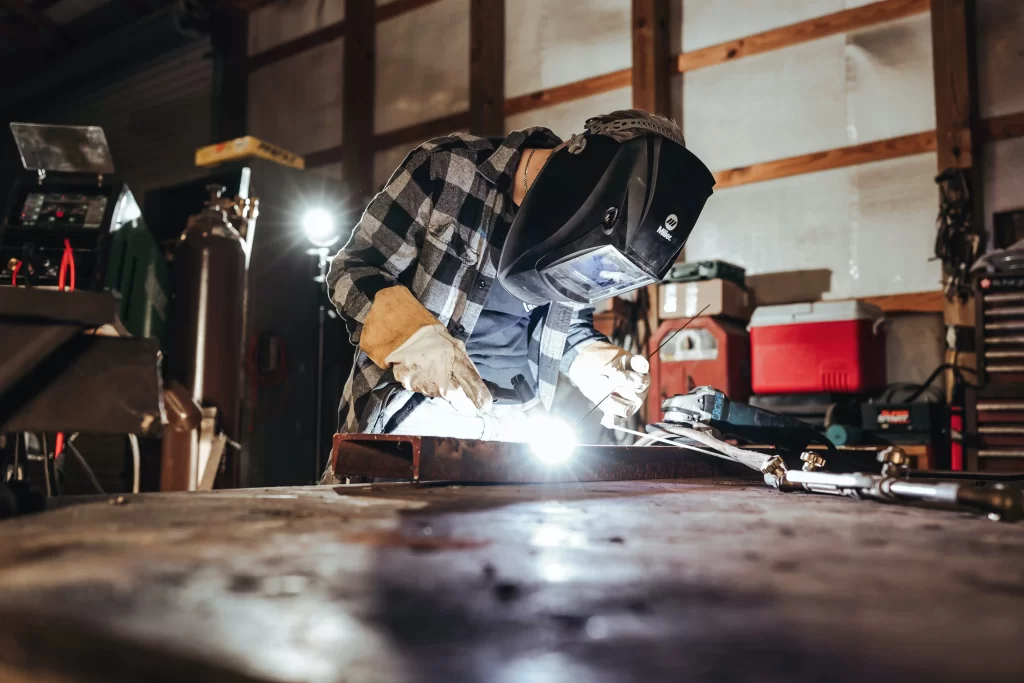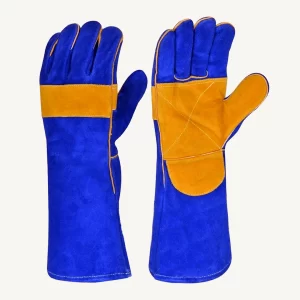Whether you’re a professional welder or a hobbyist setting up a new home workshop, having the right pair of welding gloves is crucial for protecting your hands. But with so many options on the market, how do you determine which welding gloves are best for your specific needs? This comprehensive guide breaks down the key factors to consider when choosing quality MIG (metal inert gas) and TIG (tungsten inert gas) welding gloves. We’ll discuss critical safety features, materials used, fit and comfort considerations, and tips for getting the longest use from your new welding gloves.
Types Of Welding Gloves
The two main types of electric welding where gloves are essential protective equipment are MIG and TIG welding.
Here’s a quick overview:
MIG Welding Gloves
MIG welders use an electric arc between a continuous wire electrode and the base metal to fuse materials together. The wire electrodes run on high voltages ranging from 115 to 150 Amps for steel and 215 to 575 Amps for aluminium. Significant spatter and heat are produced. MIG welding requires flexible gloves that protect against high heat, flame, and spatter. Leather is the most commonly used material due to its versatility, dexterity, and durability. Premium MIG welding gloves are typically made from elk skin or deer skin leather.
TIG Welding Gloves
TIG welders use a non-consumable tungsten electrode with an inert gas supply to create a stable, low-spatter arc. The lower heat of TIG welding allows for thinner, more precise welds making dexterity especially important. Thin leather or fabric TIG gloves are ideal for maximum finger sensitivity. Premium TIG welding gloves feature precise seams that resist fraying while enhancing grip.
Key Factors When Choosing Welding Gloves
Welders require gloves specifically designed to safeguard from burns and radiation while allowing adequate movability and grip control for handling hot materials and welding implements. Consider the following features when selecting the right pair:
Safety Ratings
The work you undertake determines the level of protection needed. Welding gloves comply with one or more safety standards:
- ANSI/ISEA 105 American National Standards Institute standards for hand protection – mechanical and thermal properties.
- EN 12477 European standard rates TIG gloves from Class 0 (lightest duty) to Class 2 (heavy duty).
- EN 388 Abrasion, cut, tear and puncture resistance ratings. Class 0 is the minimum protection level, Class 4 the highest.
- EN 407 Heat resistance ratings from Contact Heat level 1 to Convective Heat level 4.
- Suitable for electrical insulation class 00 (500V) to class 4 (36,000V).
Materials
The materials used directly impact the durability, thermal protection, and dexterity the gloves provide. Common options include:
- Split cowhide leather – Cost-effective and flexible. Medium-duty applications.
- Goatskin leather – Lightweight and thin. Precision tasks.
- Deerskin and elkskin leather – Soft and pliable. Comfortable fit.
- Pigskin leather – Resists heat/flame. Heavy duty MIG.
- Sheepskin leather – Greater insulation than cowhide. Increased comfort.
- Cotton – Light-duty. Often lined leather gloves.
- FR treated materials – Flame resistant cotton or leather.
Fit and Comfort
Welding generates significant heat. A proper glove fit ensures better protection and fatigue reduction by avoiding hot spots. Consider:
- Individual finger slots vs mitten-style fingers. Mitten fingers limit dexterity.
- Wing thumb and contoured palm: Enhanced grip and mobility.
- Elastic/Velcro wrist closures prevent hot sparks entering the glove.
- Length to adequately cover the wrist and forearm.
- Lightweight materials to minimize fatigue.
Make sure to try gloves on both hands and simulate welding motions before purchasing.
Intended Use
Your specific welding process narrows suitable glove choices. Factors like duty cycle percentages, amperage, feed rates materials, joint types, and position all impact needs. Lighter gloves enhance finger sensitivity for intricate TIG welds. Heavier leather suits repetitive MIG production environments. Specialty gloves feature added wrist coverage or panels over glove backs to further protect from stray sparks and spatter. Consider extra insulation or liquid resistant coatings handling hot or cold specialty alloys.
How to Clean welding gloves?
Proper care extends the usable lifespan of leather gloves. Here are some useful tips:
- Allow gloves to fully dry after each use before storing to prevent cracking.
- Apply leather conditioners to restore moisture and suppleness.
- Use an old toothbrush to remove dirt and debris stuck to leather.
- When gloves become too stiff or worn to adequately protect hands, replace them.
- Mend small tears immediately with special adhesive patches to avoid further ripping.
By selecting the right pair suited to your welding processes, properly caring for them after each use, and replacing degraded gloves in a timely manner, you’ll keep hands safely protected during hot work activities.
Can You Use TIG Welding Gloves for MIG Welding?
Tig And Mig welding gloves both are the types of safety work gloves that used in welding. But question is if both are the welding gloves can we use tig welding gloves for mig welding? let’s check it out. With TIG welding gloves being thinner and more lightweight than standard MIG welding gloves, some welders consider using them in MIG applications for added comfort and finger dexterity. However, here are some important considerations before substituting TIG gloves:
Increased Risk of Injury
TIG welding generates less heat, sparks, and molten metal spatter than MIG welding. Using thin TIG gloves for MIG risks exposing hands to excessive heat. Leather may also degrade quicker requiring more frequent glove replacement.
Reduce Thermal Protection
Thinner, more flexible TIG gloves provide less insulation against high MIG heat and splatter. MIG welding can liquefy metal well above 3000°F. Specialized MIG leather shields much better.
Lack Safety Compliance
Purpose-built MIG welding gloves meet stricter regulatory standards for thermal endurance. TIG gloves don’t offer equivalent protection levels by compliance ratings. While TIG gloves allow for easy finger and hand movement, the thinner materials compromise needed safety barriers. Stick with well-rated MIG welding gloves specifically designed for your welding amperes and materials to avoid serious injury. Consider supplementing MIG gloves with thin cotton liners for additional comfort and sweat absorption.
Frequently Asked Questions
Are welding gloves electrically insulated?
Quality MIG and TIG welding gloves protect hands from electrical currents causing shocks or burns. Electrical insulation ratings indicate how well gloves resist current flow under set voltages. Class 00 provides basic 500V protection. Class 0 suits most MIG/TIG needs up to 1,500V. Class 1-4 gloves insulate from sharper current spikes up to 36,000V when stick welding. We can also used welding gloves as impact resistant work gloves for hand protection as it is heat resistant, electrically insulated, and made up from thick leather.
Are welding gloves heat resistant?
All specially designed welding gloves incorporate materials shielding from high temperatures, sparks, spatter and flames. Thicker, high quality leathers like pigskin suit MIG welding reaching over 10,000°F between the arc and workpiece. TIG welding uses lower heat where thinner gloves enhance finger dexterity.
Can you wash welding gloves?
Gloves exposed to oil, grease, dirt and grime accumulate skin irritants if not cleaned. Use mild dish soap on external glove surfaces only while avoiding leather saturating insides. Thoroughly rinse off all soap then air dry completely. Condition leather afterward. Follow manufacturer care guidelines before machine washing gloves claiming washability.
Conclusion
Welding remains one of the most hazardous metal fabrication processes. Correct PPE minimizes risks from common welding dangers like arc eye, radiation burns, heat stress, fire hazards, and lung damage from fume inhalation. Damaged hands directly threaten long-term career and quality of life impacts. Leverage this buyer’s guide information to select high quality, properly rated welding gloves suited to your specific welding processes. Take the time to regularly inspect, maintain, and replace worn gloves. Making smart hand protection investments keeps welders productive while preventing trips to the ER or doctor’s office!






